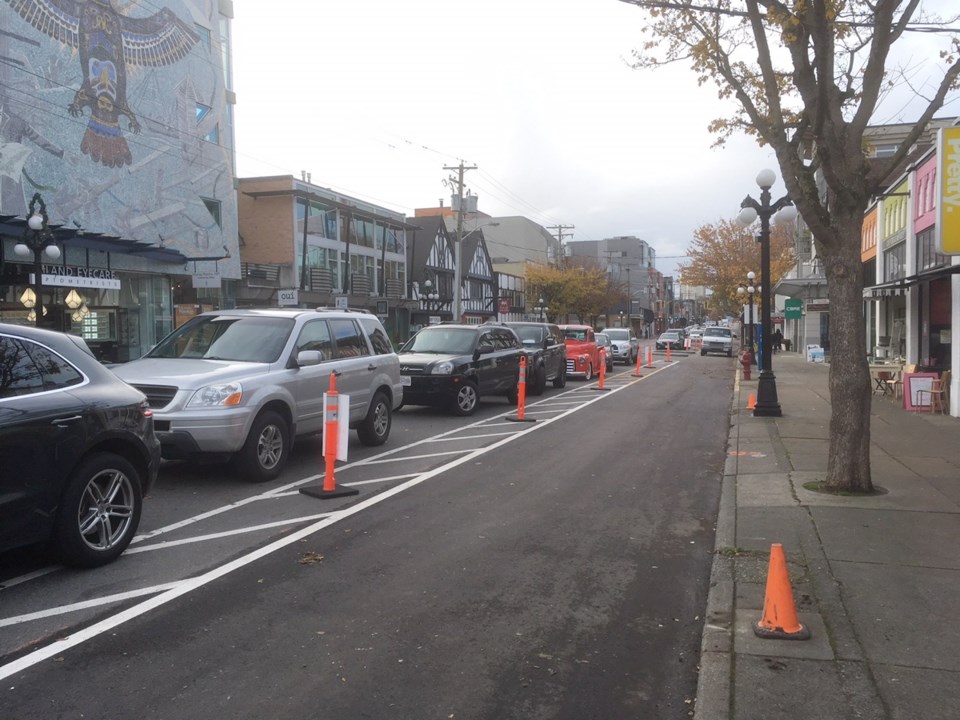Victoria councillors gave the green light Thursday to spending another $3 million to complete the first phase of the city’s protected bike lane network.
The money, to come primarily from gas tax grants, will bring the total cost of the 5.4-kilometre downtown network to an estimated $14.5 million — almost $2.7 million a kilometre, and about double the $7.75 million the city initially set aside.
Mayor Lisa Helps said the bike network is exactly what the gas tax money is for.
“We’re behind many other major cities in North America and I don’t think we should stop now because that way we’ll never get caught up,” Helps said.
Staff say the downtown section is the most difficult part of the planned 32-kilometre all-ages-and-abilities bike network and that costs are expected to drop as it expands into areas outside downtown.
“This is the toughest part of the job right now,” said Sarah Webb, the city’s active transportation project manager. “When you look to cities all across North America, these are the hardest nuts to crack.”
City staff estimate that $7.85 million is needed to complete the Wharf, Humboldt and Cook street segments of the project. About $4.86 million of that is already available.
Several factors are driving up spending, including construction market cost increases of between 25 and 30 per cent.
The scope of the project has also expanded to include the likes of signal upgrades, pedestrian improvements and on-street parking. In some cases, officials say, those changes were made in response to public input. One example is the extra $500,000 to save six parking spots in the 600 block of Fort Street.
“I’m conscious of the fact that there are significant … concerns around costs that are escalating,” Coun. Marianne Alto said.
“But I don’t see waiting making those costs better. I actually think it makes them worse.”
Coun. Jeremy Loveday agreed and called the downtown network “a minimum grid.”
“It’s called that because it’s the minimum you can do and to get the effects of a network. So I think that’s what we’re doing here is building a downtown minimum grid,” Loveday said.
While he was “alarmed” to see the cost increases, Loveday said he has heard from a lot of people who are eager to have a north-south protected cycling route and to see work on the Cook Street lane get underway.
Helps agreed that getting to the minimum grid is crucial to the project’s success. “That’s when you start to see the shift — when parents are going to actually take their eight-year-olds on their bikes downtown because they can get around safely. So that’s when the real transformation happens,” Helps said after the meeting.
Coun. Geoff Young wondered if there wasn’t some way the city could reduce costs on some sections of the project — for example, using large plastic planters to separate cyclists from motor vehicles — and upgrade later.
“The reasons that are given in opposition to those possibilities are in some cases safety, but it’s also suggested that in some cases the reason we don’t want to do that is esthetics or reputational risks — poor design quality,” he said.
“Unfortunately, the [cost] overrun represents a reputational risk, which is also serious.”
He said costs could drop significantly if the construction market cools.
Staff will report back to council when the final three sections are at 60 per cent design with updated cost estimates and input from public engagement.
They have been directed to pay particular attention to design issues relating to accessibility challenges, in particular when people are parking adjacent to a bike lane or crossing a bike lane to the curb from a bus stop.
Coun. Pam Madoff said “there are really significant issues” for people with disabilities and parents pushing strollers as they get out of vehicles and cross the bike lanes.
Phase one of the bike network includes:
• Protected two-way bike lanes on Pandora Avenue and Fort Street between Cook and Wharf streets.
• Protected two-way bike lanes on the west side of Wharf between the Johnson Street Bridge and Government Street.
• Protected two-way bike lanes on the south side of Humboldt Street between Government and Douglas streets, and shared road use between Douglas and Cook.
• One-way protected bike lanes on both sides of Cook Street between Pandora and Pakington Street.



